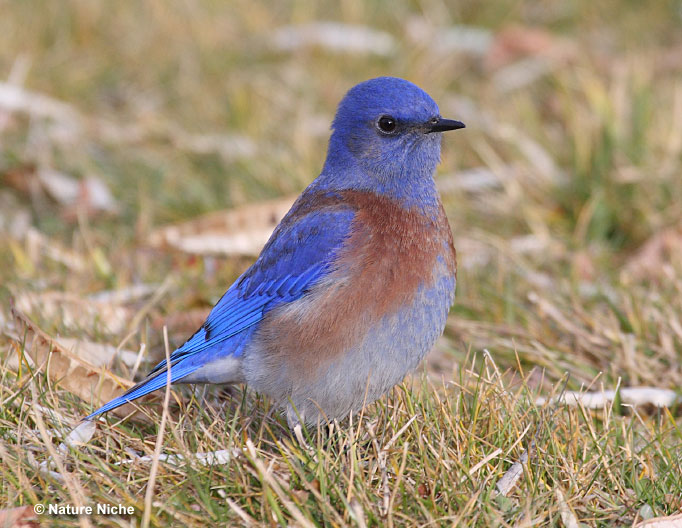The Western Bluebird is a small thrush that generally perches upright. They are stocky birds with relatively short tails and straight, thin bills.
Western Bluebirds can be found in open parklands of the western portions of the United States. They sit on perches low in trees and shrubs and swoop to the ground to catch insects. These birds nest in nest boxes or holes in trees and usually gather in small flocks outside the breeding season to feed on berries or insects. They make quiet, chortling calls.
On this page
Identification
Male Western Bluebirds have rust-orange that extends from the breast to the upper back and are bright blue above. These birds are 6.3 to 7.5 inches long, weigh 0.8 to 1.1 ounces, and have a wingspan of 11.4 to 13.4 inches. That makes them smaller than an American Robin and larger than a sparrow.
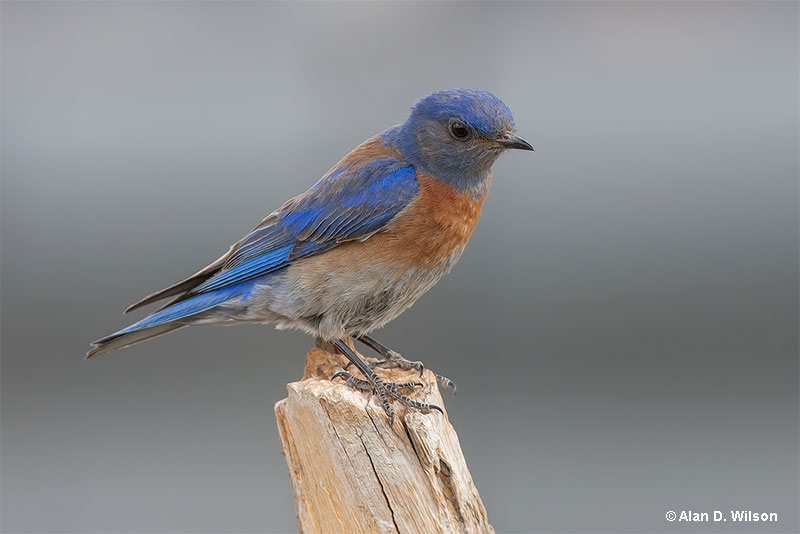
© Alan D. Wilson
Female Western Bluebirds have a tinge of blue on the tail and wings, are gray-buff overall, and have pale orange on the breast. The throat is gray-buff in females and blue in males. Their lower belly is whitish as well. They’re the same size and length as males.
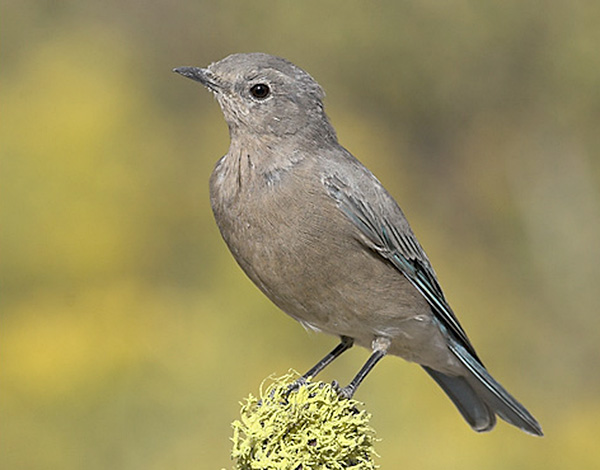
Female Western Bluebird
Juvenile Western Bluebirds look similar to female Western Bluebirds.
Food
In the summer months, Western Bluebirds primarily consume insects. In the winter months, they primarily consume seeds and fruits and supplement their diet with insects.
They usually catch insects on the ground, like caterpillars, grasshoppers, beetles, wasps, pillbugs, and ants, as well as snails and spiders. They’ve even been seen capturing marine invertebrates on beaches.
Winter foods may include berries like grapes, elderberries, mistletoe, blackberries, raspberries, sumac, serviceberry, chokecherries, poison oak, and juniper.
Nesting and Eggs
A mated pair of Western Bluebirds will search for a nesting site together. They’ll investigate a variety of cavities until they find one that’s suitable. Nests are placed in nesting cavities in either living or dead trees. Many kinds of trees are used, including oak, pine, sycamore, aspen, cottonwood, and willow.
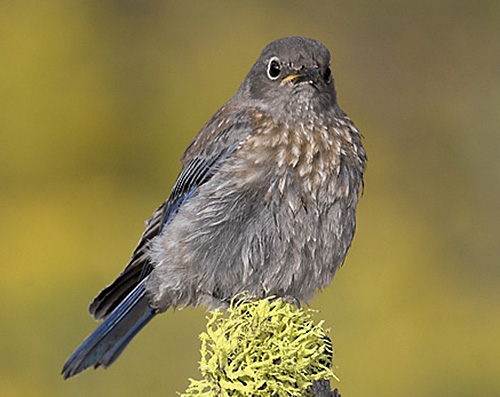
Juvenile Western Bluebird
However, it’s important to note that Western Bluebirds do not make their own cavities. The cavity must already exist in these types of trees. Natural tree cavities, as well as previously used woodpecker holes, are usually their ideal choice.
Western Bluebirds are very willing to use nest boxes, so if you want to attract these birds to your yard, we highly recommend you hang up a nest box.
Female Western Bluebirds are the ones to do all of the nest building. They carry straw, grasses, moss, pine needles, and fur to the nest. Then, she’ll line the cup of the nest with rootlets, grasses, feathers, plastic, and horsehair.
Since the nests are inside a cavity, the nest cup is not regularly shaped or as tightly woven as a typical one. It can take up to 2 weeks to make the nest.
- The clutch size is 2 to 8 eggs.
- Western Bluebirds have 1 to 3 broods per season.
- Egg length can be anywhere from 0.8 to 2.4 inches (2 to 6 centimeters).
- Egg width can be anywhere from 0.7 to 0.9 inches (1.8 to 2.4 centimeters).
- The incubation period is 12 to 17 days.
- The nestling period is 18 to 25 days.
- Eggs are white to pale blue and unmarked.
Current Situation
Western Bluebirds are a very common bird and have populations that have held steady from the late 1960s to 2019. Their breeding population is estimated to be 7.1 million.
The main threats to this species are loss of habitat from extensive logging and the suppression of natural fires, which causes the growth of forests.
Additionally, grazing and development have lowered habitat availability. It’s not uncommon for people to remove dead trees in an effort to clean up the area, but doing this can limit the places where cavity nesters like Western Bluebirds can nest.
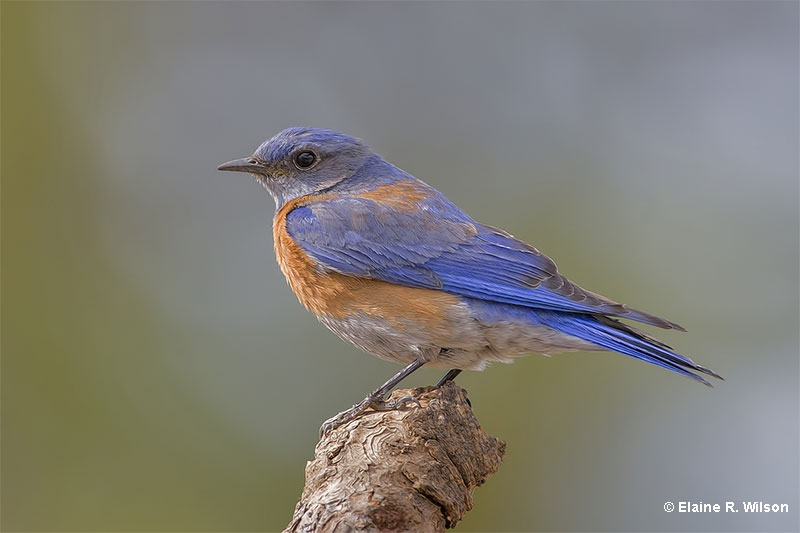
© Elaine R. Wilson
Western Bluebirds live at the edges of woods and in open woodlands. You’ll unlikely see them in large meadows like other bluebird species.
Instead, they live in deciduous and evergreen woods, specifically pinyon pine-juniper, ponderosa pine, aspen stands, and mixed conifers. They thrive in logged areas that still contain dead trees since they’re perfect for perching and nesting and in disturbed areas such as burned forests. During the winter months, these birds inhabit stands of mesquite, oak, streamside woods, pinyon-juniper woods, desert, and coastal chaparral.
Facts
- Western Bluebirds look like gentle birds, but don’t let them fool you. They participate in territory battles that can get pretty heated. For example, rival male Western Bluebirds will grab at each other’s legs, fall to the ground, and pin their opponent to the ground. Once they have the opponent pinned, he’ll stand over him and poke at him with his bill.
- Research has shown that a lot of Western Bluebird hatchlings have dads who are not the bond male.
- The oldest recorded Western Bluebird lived to be at least 8 years and 8 months old. It was a male who was first banded in California in 2001. He was found again later in the same state in 2008.
- Bluebirds symbolize hope and joy, among other things.
Similar Species
The Western Bluebird has features that are similar to other birds. Here are some similar species:
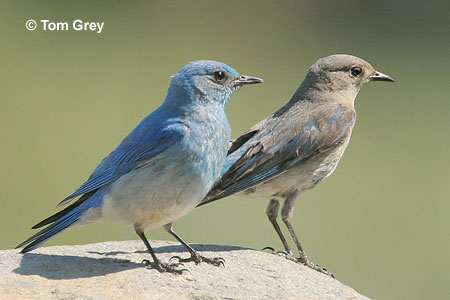
Mountain Bluebirds
Male Western Bluebirds are darker than male Mountain Bluebirds and have rusty bellies that male Mountian Bluebirds do not have.
Female/immature Western Bluebirds are darker than female/immature Mountain Bluebirds.
Additionally, Western Bluebirds have more rusty coloring than Mountains.
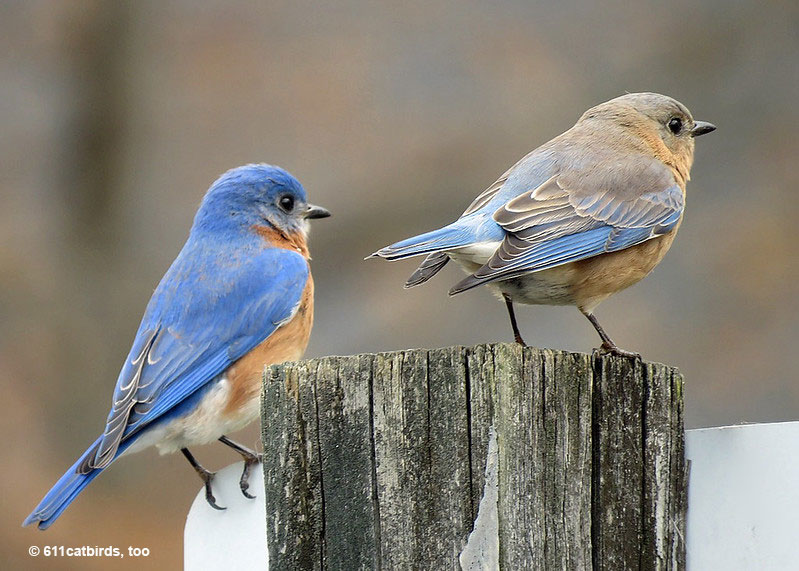
Pair of Eastern Bluebirds © 611catbirds, too
Male Western Bluebirds have blue throats, while male Eastern Bluebirds have rusty throats.
Female Western Bluebirds have gray throats, grayish heads, and no rusty wash, while female Eastern Bluebirds have white throats and a rusty wash on their necks.
Frequently Asked Questions
Is the Western Bluebird rare?
No, the Western Bluebird is not rare. These birds have a decent range and a stable population.
What is the difference between Western and Eastern Bluebirds?
Male Western Bluebirds have blue throats, while male Eastern Bluebirds have rusty throats. Additionally, female Western Bluebirds have gray throats, grayish heads, and no rusty wash, while female Eastern Bluebirds have white throats and a rusty wash on their necks.
Where do Western Bluebirds live?
Western Bluebirds live at the edges of woods and in open woodlands. You’ll unlikely see them in large meadows like other Bluebird species. Instead, they live in deciduous and evergreen woods, specifically pinyon pine-juniper, ponderosa pine, aspen stands, and mixed conifers. They thrive in logged areas that still contain dead trees since they’re perfect for perching and nesting and in disturbed areas such as burned forests. During the winter months, these birds inhabit stands of mesquite, oak, streamside woods, pinyon-juniper woods, desert, and coastal chaparral.
Do bluebirds return to the same box every year?
So Bluebirds will return to the same nesting box every year while others don’t. According to some studies, 26% to 44% of adult bluebirds return to the same site to breed. This means there’s around a 1 to 3 % chance that the bluebirds you had in your nest box will revisit.
What does seeing a Western Bluebird mean?
It’s believed that bluebirds represent hope and joy. So if you see one, there’s a chance that good news will arrive soon.

